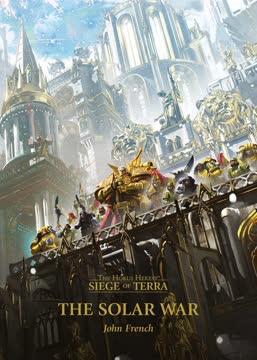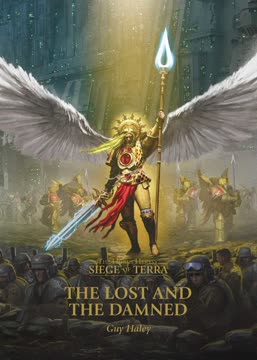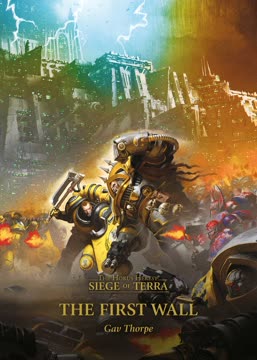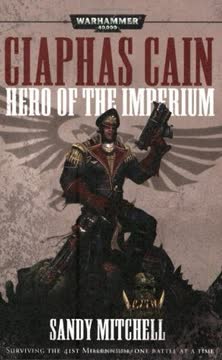Plot Summary
Shadows of the Inquisition
In the grim darkness of the 41st millennium, the Imperium of Man is beset by threats from within and without. The Inquisition, a secretive and powerful order, stands as humanity's last line of defense against heresy, mutation, and the corrupting touch of Chaos. Among its agents is Gregor Eisenhorn, a puritanical inquisitor whose devotion to the Emperor is matched only by his relentless pursuit of the Imperium's enemies. Eisenhorn's story is one of duty, sacrifice, and the ever-present temptation to use forbidden means for righteous ends.
The Hunt Begins
Eisenhorn's career is defined by his dogged pursuit of heretics and recidivists. His early years are marked by the hunt for Murdin Eyclone, a notorious Chaos facilitator, which takes him to the frozen world of Hubris. There, Eisenhorn's investigation leads to a massacre in the hibernation tombs, the loss of trusted allies, and the first hints of a conspiracy that stretches far beyond a single cult. The seeds of a greater darkness are sown as Eisenhorn realizes that the true enemy is not just the heretic, but the insidious corruption that can infect even the most loyal servants of the Emperor.
Web of Heresy
As Eisenhorn's investigations deepen, he uncovers a web of interconnected cults, forbidden technologies, and ancient secrets. The trail leads from the icy tombs of Hubris to the decadent courts of Gudrun, the hive cities of Thracian Primaris, and the shadowy dealings of the powerful Glaw family. Eisenhorn's band of allies grows—each with their own skills and burdens—but so too does the cost of their loyalty. The Inquisition's internal divisions between puritans and radicals become ever more pronounced, and Eisenhorn is forced to question the limits of his own methods.
The Enemy Within
The true enemy is not always obvious. Eisenhorn's greatest challenges come not from xenos or daemons, but from the subtle, pervasive influence of Chaos within the Imperium itself. Trusted officials, noble houses, and even fellow inquisitors may be tainted. The pursuit of the heretic Pontius Glaw, whose mind survives in a forbidden engram device, becomes a personal and philosophical battle. Eisenhorn's encounters with daemonhosts—humans possessed by daemons—force him to confront the possibility that the tools of the enemy might be turned to the service of the Emperor, at a terrible price.
The Price of Purity
Eisenhorn's puritanical ideals are tested as the stakes rise. The loss of friends, the destruction of entire organizations, and the ever-present threat of damnation weigh heavily on him. The Inquisition's own politics become a battlefield, with Eisenhorn accused of heresy and hunted by his former allies. The line between puritan and radical blurs as he is forced to use radical means—binding daemonhosts, wielding proscribed texts, and making pacts with xenos seers—to combat threats that would otherwise be unstoppable. Each victory comes at a cost, and Eisenhorn must decide how much of his soul he is willing to sacrifice.
Daemonhost Unleashed
In the face of overwhelming danger, Eisenhorn turns to the most dangerous weapon in his arsenal: the daemonhost Cherubael. Created through forbidden rituals and bound with the knowledge of the heretical Malus Codicium, Cherubael is both a tool and a curse. Its power is unmatched, but its loyalty is always in question. The use of such a weapon marks a turning point in Eisenhorn's journey, as he crosses the line from puritan to radical, and the consequences of this choice ripple through his life and the lives of those around him.
The Radical's Path
As Eisenhorn's methods grow more extreme, he is forced to confront the reality that the Inquisition's greatest strength—its independence—is also its greatest weakness. The pursuit of justice becomes a personal crusade, and Eisenhorn's willingness to bend or break the rules isolates him from his peers. The deaths of friends, the destruction of the Distaff (his cadre of untouchables), and the betrayal of trusted allies like Godwyn Fischig drive home the cost of victory. The line between puritan and radical becomes ever more tenuous.
The Fall of Friends
The war against Chaos is not fought alone. Eisenhorn's band of allies—Bequin, Fischig, Nayl, Aemos, Medea, and others—are as much victims of his crusade as they are its champions. The systematic destruction of his organization by Pontius Glaw, the deaths of beloved companions, and the ultimate betrayal by Fischig, who turns on Eisenhorn in the name of purity, underscore the loneliness of the inquisitor's path. The cost of victory is paid in blood and trust.
The Maze of Ghul
The pursuit of Glaw leads Eisenhorn to the dead world of Ghul, a planet inscribed with impossible geometries and haunted by the legacy of a daemon-king. Here, the boundaries of reality and the warp blur, and the true nature of the enemy is revealed. Glaw, now a man-machine hybrid, seeks the ultimate weapon: the barque of Yssarile, a daemon-king's chariot of apocalypse. Eisenhorn, crippled and desperate, must rely on every resource—mortal and otherwise—to prevent catastrophe.
The Living Blade
The final battle between Eisenhorn and Glaw is both physical and metaphysical. Glaw, armored in a body of steel and blades, is the embodiment of radicalism gone mad—a once-great servant of the Emperor now consumed by the very evil he sought to destroy. Eisenhorn, wielding the last remnants of his faith and the broken blade Barbarisater, must defeat not only Glaw but the temptation to become like him. The destruction of the Malus Codicium and the shattering of Glaw's engram crystal mark the end of one threat, but not the end of the struggle.
The Last Stand
The defeat of Glaw comes at a terrible price. Eisenhorn is left crippled, his organization in ruins, and his soul scarred by the choices he has made. The daemonhost Cherubael, once a tool, now becomes a lingering threat—a reminder that the line between radical and heretic is perilously thin. The Inquisition's own politics remain as treacherous as ever, and Eisenhorn's future is uncertain. The war against Chaos is never truly won.
The Line Crossed
In the aftermath, Eisenhorn is forced to confront the reality of what he has become. The trust of friends is lost, the respect of the Inquisition is forfeit, and the burden of his actions weighs heavily. Yet, in the end, he has done the Emperor's work—at a cost that may never be fully reckoned. The line between puritan and radical is not a wall, but a path, and Eisenhorn walks it alone.
The Emperor's Work
The story of Eisenhorn is not one of triumph, but of endurance. The Inquisition's work is never done, and the enemies of mankind are endless. Eisenhorn's journey is a testament to the complexity of faith, the necessity of compromise, and the inevitability of loss. The Emperor's work is not about victory, but about holding the line—no matter the cost.
The Cost of Victory
In the end, Eisenhorn survives, but at what cost? The deaths of friends, the destruction of his organization, and the taint of radicalism leave him a changed man. The tools he has used—daemonhosts, forbidden texts, xenos allies—are both his salvation and his damnation. The war against Chaos continues, and Eisenhorn's legacy is one of both warning and inspiration.
The End and the Beginning
Eisenhorn's story ends as it began: in the shadows, fighting a war that can never be won. The lessons of his life are not simple. The line between hero and heretic is thin, and the cost of victory is often more than any one man can bear. Yet, in the end, Eisenhorn's tale is a testament to the enduring struggle for humanity's soul in a universe without mercy.
Characters
Gregor Eisenhorn
Eisenhorn is the central figure of the trilogy, a puritanical inquisitor whose devotion to the Emperor is matched only by his willingness to do whatever it takes to defeat the enemies of mankind. Over the course of his career, Eisenhorn evolves from a strict puritan to a radical, forced by circumstance and necessity to use the very tools of the enemy he despises. His relationships—with allies, with the Inquisition, and with his own conscience—are marked by loyalty, loss, and the ever-present threat of damnation. Eisenhorn's journey is one of moral ambiguity, as he struggles to balance the demands of duty with the cost to his soul.
Alizebeth Bequin
Bequin is Eisenhorn's closest confidante and the leader of the Distaff, a cadre of psychic blanks whose presence disrupts the powers of psykers and daemons. Her relationship with Eisenhorn is deeply emotional, marked by unspoken love and the tragedy of their mutual incompatibility—he a psyker, she an untouchable. Bequin's loyalty and courage are unwavering, but she ultimately becomes a victim of the war against Chaos, her fate a symbol of the personal cost of Eisenhorn's crusade.
Godwyn Fischig
Fischig begins as an arbites officer and becomes Eisenhorn's most trusted ally and moral compass. His unwavering commitment to the law and the Emperor makes him both a strength and a liability, as he is unable to follow Eisenhorn down the path of radicalism. Fischig's eventual betrayal—shooting Eisenhorn in an attempt to "save" him—underscores the tragic consequences of ideological purity and the fragility of trust.
Harlon Nayl
Nayl is a former bounty hunter whose skills and loyalty make him an indispensable member of Eisenhorn's team. He is a survivor, adaptable and unflinching in the face of danger. Nayl's pragmatism and willingness to do what must be done contrast with the idealism of other characters, and his survival through the destruction of the Distaff and the war against Glaw is a testament to his resilience.
Uber Aemos
Aemos is Eisenhorn's oldest companion, a savant whose compulsion to collect and analyze information is both a gift and a curse. His encyclopedic knowledge and analytical mind are invaluable, but his obsession ultimately leads to his downfall, as he is corrupted by the very knowledge he seeks. Aemos's fate is a warning about the dangers of forbidden lore and the limits of human endurance.
Medea Betancore
The daughter of Eisenhorn's late friend Midas Betancore, Medea is a gifted pilot whose loyalty and courage are matched by her emotional intensity. Her quest for vengeance and her struggle to find meaning in the aftermath of loss mirror Eisenhorn's own journey. Medea's relationship with Eisenhorn is complex, marked by mutual respect, frustration, and the shared burden of survival.
Pontius Glaw / Khanjar the Sharp
Glaw is the central antagonist, a once-noble inquisitor whose mind survives in a forbidden engram device. Over centuries, he becomes a master manipulator, orchestrating conspiracies and seeking ultimate power. His transformation into a man-machine hybrid, Khanjar the Sharp, is the embodiment of radicalism gone mad—a warning of what happens when the ends justify any means. Glaw's pursuit of the daemon-king's barque is both a personal vendetta and a threat to the galaxy.
Cherubael
Cherubael is a daemonhost—an entity of the warp bound into a human body—created and controlled by Eisenhorn through forbidden rituals. Cherubael is both a tool and a curse, its power unmatched but its loyalty always in question. The relationship between Eisenhorn and Cherubael is fraught with danger, temptation, and the ever-present risk of corruption. Cherubael's presence is a constant reminder of the thin line between radical and heretic.
Gideon Ravenor
Once Eisenhorn's pupil, Ravenor becomes a powerful inquisitor in his own right, despite being confined to a life-support chair after catastrophic injuries. His psychic abilities and analytical mind make him a formidable ally, and his willingness to use xenos knowledge and forbidden means reflects the evolution of the Inquisition itself. Ravenor's visions and insights are crucial to the final confrontation with Glaw.
Tobias Maxilla
Maxilla is a flamboyant and resourceful rogue trader whose ship, the Essene, serves as a mobile base for Eisenhorn's operations. His loyalty, wit, and willingness to bend the rules make him an invaluable ally. Maxilla's death at the hands of the Inquisition is a poignant reminder of the collateral damage of Eisenhorn's war.
Plot Devices
First-person narrative and unreliable memory
The trilogy is told through Eisenhorn's first-person voice, allowing readers intimate access to his thoughts, doubts, and rationalizations. This perspective is both a strength and a limitation, as Eisenhorn's memory is colored by trauma, guilt, and the need to justify his actions. The unreliable narrator device deepens the psychological complexity of the story, forcing readers to question the nature of truth, memory, and self-deception.
The line between puritan and radical
The internal divisions of the Inquisition—puritan versus radical—are not just background, but the engine of the plot. Eisenhorn's journey from puritan to radical is mirrored in his relationships, his methods, and his ultimate fate. The line between hero and heretic is a recurring motif, explored through dialogue, action, and the consequences of Eisenhorn's choices.
Daemonhosts and forbidden knowledge
The creation and use of daemonhosts, especially Cherubael, is the most potent plot device in the trilogy. It represents the ultimate temptation: the power to fight evil with evil. The Malus Codicium, a proscribed grimoire, is both a key to victory and a source of corruption. The use of these tools is foreshadowed throughout, and their consequences are both immediate (victory in battle) and long-term (the loss of friends, the taint of heresy).
Foreshadowing and prophecy
The eldar farseer's prophecies, Ravenor's visions, and the recurring dreams of Eisenhorn all serve to foreshadow key events and reinforce the theme of inevitability. The sense that the future is both knowable and unchangeable adds a layer of tragedy to the narrative, as characters struggle against destinies they cannot escape.
The cost of victory
Every major victory in the trilogy is paid for with loss—of friends, of innocence, of faith. The structure of the story is cyclical, with each triumph leading to a new, greater cost. The destruction of the Distaff, the deaths of beloved allies, and Eisenhorn's own physical and moral decline are all foreshadowed and paid off in the narrative's relentless march toward ambiguity.
Analysis
Dan Abnett's trilogy is not just a tale of action and intrigue, but a psychological study of a man who is forced, by necessity and conviction, to become the very thing he once hunted. The story's power lies in its refusal to offer easy answers: Eisenhorn's victories are always tainted, his methods always suspect, and the line between hero and heretic is never clear. The lessons of the trilogy are both cautionary and inspiring: that the fight against evil is endless, that the cost of victory is often more than one can bear, and that the greatest threat to humanity may come not from without, but from within. In a modern context, Eisenhorn's journey is a warning about the dangers of ideological purity, the necessity of compromise, and the enduring struggle to do what is right in a world where right and wrong are never simple.
Last updated:
Review Summary
Eisenhorn is highly praised as an excellent introduction to the Warhammer 40K universe. Readers appreciate the complex characters, intricate plot, and vivid world-building. The trilogy follows Inquisitor Gregor Eisenhorn's journey from puritan to radical, exploring themes of morality and corruption. Many consider it one of the best sci-fi series, even for those unfamiliar with Warhammer. The omnibus edition, containing three novels and two short stories, is widely recommended for its gripping narrative, atmospheric setting, and Abnett's skillful writing, though some find the pacing inconsistent.
Similar Books
Download PDF
Download EPUB
.epub digital book format is ideal for reading ebooks on phones, tablets, and e-readers.













